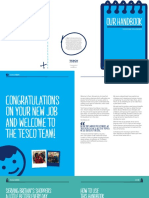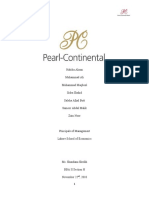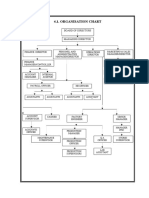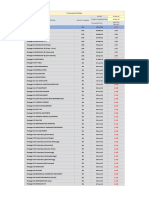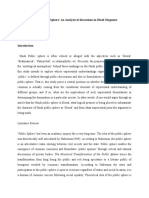4.7 Artifacts Applied Across Performance
4.7 Artifacts Applied Across Performance
Uploaded by
Ammar YasirCopyright:
Available Formats
4.7 Artifacts Applied Across Performance
4.7 Artifacts Applied Across Performance
Uploaded by
Ammar YasirOriginal Title
Copyright
Available Formats
Share this document
Did you find this document useful?
Is this content inappropriate?
Copyright:
Available Formats
4.7 Artifacts Applied Across Performance
4.7 Artifacts Applied Across Performance
Uploaded by
Ammar YasirCopyright:
Available Formats
4.6.
9 OTHE R ARTIFACTS
The documents and deliverables described here do not fit into a specific category; however,
they are important artifacts that are used for a variety of purposes.
▶ Activity list. This document provides a tabulation of schedule activities that shows the
activity description, activity identifier, and a sufficiently detailed scope of work description
so project team members understand what work is to be performed.
▶ Bid documents. Bid documents are used to request proposals from prospective sellers.
Depending on the goods or services needed, bid documents can include, among others:
▹ Request for information (RFI),
▹ Request for quotation (RFQ), and
▹ Request for proposal (RFP).
▶ Metrics. Metrics describe an attribute and how to measure it.
▶ Project calendar. This calendar identifies working days and shifts that are available
for scheduled activities.
▶ Requirements documentation. This document is a record of product requirements and
relevant information needed to manage the requirements, which includes the associated
category, priority, and acceptance criteria.
▶ Project team charter. This document records the project team values, agreements,
and operating guidelines, and establishes clear expectations regarding acceptable behavior
by project team members.
▶ User story. A user story is a brief description of an outcome for a specific user, which
is a promise of a conversation to clarify details.
4.7 ARTIFAC T S AP P L IE D A C R O S S P E R F O R M A NC E DO M A I NS
Different artifacts are more likely to be useful in different performance domains. While the
delivery approach, product, and organizational environment will determine which artifacts are most
applicable for a specific project, there are some performance domains that are more likely to make
use of specific artifacts. Table 4-3 suggests the performance domain(s) where each artifact is more
likely to be of use; however, the project manager and/or project team has the ultimate responsibility
for selecting and tailoring the artifacts for their project.
192 PMBOK ® Guide
Table 4-3. Mapping of Artifacts Likely to Be Used in Each Performance Domain
Performance Domain
Measurement
Stakeholders
Project Work
Dev Approach
and Life Cycle
Uncertainty
Planning
Delivery
Artifact
Team
Strategy Artifacts:
Business case X X
Project brief X X
Project charter X X
Project vision statement X X
Roadmap X X X
Log and Register Artifacts:
Assumption log X X X X
Backlog X X X
Change log X X
Issue log X
Lessons learned register X
Risk-adjusted backlog X X
Risk register X X X X
Stakeholder register X X
Plan Artifacts:
Change control plan X X X
Communications management plan X X X
Cost management plan X
Iteration plan X
Procurement management plan X X
Project management plan X X X
Quality management plan X X X
Release plan X X
Requirements management plan X X
Resource management plan X X
Risk management plan X X X
Scope management plan X X
Section 4 – Models, Methods, and Artifacts 193
Table 4-3. Mapping of Artifacts Likely to Be Used in Each Performance Domain (cont.)
Performance Domain
Measurement
Stakeholders
Project Work
Dev Approach
and Life Cycle
Uncertainty
Planning
Delivery
Artifact
Team
Schedule management plan X X X
Stakeholder engagement plan X X
Test plan X X X X
Hierarchy Chart Artifacts:
Organizational breakdown structure X X X
Product breakdown structure X X
Resource breakdown structure X X X X
Risk breakdown structure X X
Work breakdown structure X X X
Baseline Artifacts:
Budget X X X
Milestone schedule X X X X
Performance measurement baseline X X X X
Project schedule X X X
Scope baseline X X X X
Visual Data and Information Artifacts:
Affinity diagram X X
Burn chart X X X
Cause-and-effect diagram X X X
Cycle time chart X X
Cumulative flow diagram X X
Dashboard X X
Flow chart X X X
Gantt chart X X X
Histogram X
Information radiator X X
Lead time chart X X
Prioritization matrix X X X
194 PMBOK ® Guide
Table 4-3. Mapping of Artifacts Likely to Be Used in Each Performance Domain (cont.)
Performance Domain
Measurement
Stakeholders
Project Work
Dev Approach
and Life Cycle
Uncertainty
Planning
Delivery
Artifact
Team
Project schedule network diagram X X
Requirements traceability matrix X X X
Responsibility assignment matrix X X
Scatter diagram X X X
S-curve X X
Stakeholder engagement assessment matrix X X X
Story map X X
Throughput chart X X
Use case X X
Value stream map X X X
Velocity chart X X
Report Artifacts:
Quality report X X X
Risk report X X
Status report X
Agreements and Contracts:
Fixed-price X X X X X X
Cost-reimbursable X X X X X X
Time and materials X X X X X X
Indefinite time indefinite quantity (IDIQ) X X X X X X
Other agreements X X X X X X
Other Artifacts:
Activity list X X X X
Bid documents X X X
Metrics X X X
Project calendars X X X
Requirements documentation X X X X
Project team charter X X
User story X X X
Section 4 – Models, Methods, and Artifacts 195
You might also like
- Paraphrasing in The ECPE Oral ExamDocument2 pagesParaphrasing in The ECPE Oral Examghon fabrik100% (1)
- BHM 402T PDFDocument120 pagesBHM 402T PDFKamlesh HarbolaNo ratings yet
- Front Office ManualDocument97 pagesFront Office ManualKumarSv100% (1)
- Tesco Coll Hbook Store RP7Document32 pagesTesco Coll Hbook Store RP7Andrada BaghinaNo ratings yet
- 22 Chef ShaiffulDocument17 pages22 Chef ShaiffulLilx soneNo ratings yet
- Tourism Manager Job DescriptionDocument3 pagesTourism Manager Job DescriptionMary Jane AnarnaNo ratings yet
- Check List For Night Auditor1Document3 pagesCheck List For Night Auditor1zaw khaingNo ratings yet
- Accounting For 2Document206 pagesAccounting For 2Ean VelayoNo ratings yet
- Pre Opening TransitionDocument28 pagesPre Opening TransitionWaristha Idyzapril AnunpattanaNo ratings yet
- CVA Checklist RHHDocument45 pagesCVA Checklist RHHTanti.SaptariniNo ratings yet
- Vancouver Brand GuideDocument66 pagesVancouver Brand GuideMatt TupperNo ratings yet
- Check List and Countdown For Pre-Opening Actions: Food & Beverage DepartmentDocument3 pagesCheck List and Countdown For Pre-Opening Actions: Food & Beverage DepartmentAkang HarryNo ratings yet
- Fo SopDocument211 pagesFo SopkatariamanojNo ratings yet
- 2 HRDF Housekeeping FA V7 PDFDocument149 pages2 HRDF Housekeeping FA V7 PDFShawn WongNo ratings yet
- Total Employee's Comment: Immediate Superior's CommentDocument50 pagesTotal Employee's Comment: Immediate Superior's CommentBochoy GaloreNo ratings yet
- Brewster by The Sea: Housekeeping ManualDocument25 pagesBrewster by The Sea: Housekeeping ManualbyronNo ratings yet
- Habiba Ahsan Muhammad Ali Muhammad Maqbool Sidra Shahid Saleha Afzal Butt Sameer Abdal Malik Zain NoorDocument23 pagesHabiba Ahsan Muhammad Ali Muhammad Maqbool Sidra Shahid Saleha Afzal Butt Sameer Abdal Malik Zain NoorhonestscarryNo ratings yet
- GLASSWAREDocument86 pagesGLASSWAREEong Huat Corporation Sdn BhdNo ratings yet
- Front Office Accounting FormatsDocument10 pagesFront Office Accounting FormatsDebasish Singha100% (1)
- Notes To Departments: Generated DateDocument2 pagesNotes To Departments: Generated DateLancemachang EugenioNo ratings yet
- "On The Water" Business PlanDocument22 pages"On The Water" Business Planmohammad10000100% (2)
- F&B Director Job SpecificationsDocument4 pagesF&B Director Job SpecificationsAgustinus Agus PurwantoNo ratings yet
- SOP Banquet SampleDocument6 pagesSOP Banquet SamplebunmeongNo ratings yet
- Checkliste Ouverture 1Document30 pagesCheckliste Ouverture 1Ljupco TripcevskiNo ratings yet
- Sop 1Document7 pagesSop 1سيد شوبيرNo ratings yet
- Security in The HotelDocument12 pagesSecurity in The HotelJuan Diego García RodriguezNo ratings yet
- Conference and Banquet ProposalDocument7 pagesConference and Banquet ProposalTiurma100% (1)
- FORMATDocument8 pagesFORMATradde madhavanNo ratings yet
- Customer Preferences For Restaurant Technology InnovationsDocument22 pagesCustomer Preferences For Restaurant Technology InnovationsDeepankar SinghNo ratings yet
- F & B Control NotesDocument22 pagesF & B Control NotesADAM HASSANNo ratings yet
- AC Kitchen Experiencia de Desayuno 1Document44 pagesAC Kitchen Experiencia de Desayuno 1chef.pinedaNo ratings yet
- Scheme of Syllabi (1 & 2 Semester) : PTU/BOS/HM/110/15-04-2005/batch-2003Document99 pagesScheme of Syllabi (1 & 2 Semester) : PTU/BOS/HM/110/15-04-2005/batch-2003anon_655725442No ratings yet
- The Fern Room Service-SOPDocument31 pagesThe Fern Room Service-SOPJoydeep MajumdarNo ratings yet
- Inventory 13 14Document627 pagesInventory 13 14BùiXuânHiệp100% (1)
- HK102Document15 pagesHK102Leslie Amor NamoroNo ratings yet
- Banqueting & It's Role in F&B BusinessDocument58 pagesBanqueting & It's Role in F&B BusinessManoj SinghNo ratings yet
- Crans Montana BBA1 GroomingStandardsDocument5 pagesCrans Montana BBA1 GroomingStandardsDevansh SharmaNo ratings yet
- 01 - Quotation Letter & Corporate Rate - 2023 - IbisDocument3 pages01 - Quotation Letter & Corporate Rate - 2023 - Ibisedo permanaNo ratings yet
- Approval Guidelines of Legacy Vintage HotelsDocument32 pagesApproval Guidelines of Legacy Vintage Hotels2011.17- Akash ChoukseyNo ratings yet
- Chapter 1Document44 pagesChapter 1cucucucucu72No ratings yet
- VTOS2013 Food and Beverage Service enDocument192 pagesVTOS2013 Food and Beverage Service enThierry ThienNo ratings yet
- Agilysys InfoGenesis POS 1Document1 pageAgilysys InfoGenesis POS 1ReynanNo ratings yet
- Uniform RoomDocument14 pagesUniform RoomAnshu SinghNo ratings yet
- Closing Stock Department Wise (RRN)Document12 pagesClosing Stock Department Wise (RRN)pavan kumarNo ratings yet
- Foodcosttool How To Buffet Profitability Work Sheet 031109Document4 pagesFoodcosttool How To Buffet Profitability Work Sheet 031109Rudy Brur100% (1)
- Vinca Hospitality Pvt. Ltd. Company ProfileDocument32 pagesVinca Hospitality Pvt. Ltd. Company ProfileHMNo ratings yet
- Banquet Quotation FormatDocument2 pagesBanquet Quotation FormatRaj Kumar GhoshNo ratings yet
- Mountain Glory Forest ResortDocument21 pagesMountain Glory Forest ResortPradeep Malla100% (1)
- Dokumen - Tips - Marriott 2008 Handbook Part 2Document21 pagesDokumen - Tips - Marriott 2008 Handbook Part 2Thanh HàNo ratings yet
- Terms of Service: 1. Acceptance of Terms of Use, Conditions, Notices and DisclaimersDocument7 pagesTerms of Service: 1. Acceptance of Terms of Use, Conditions, Notices and DisclaimersxnexusNo ratings yet
- Org STRCTR 1Document1 pageOrg STRCTR 1athulkannanNo ratings yet
- Accommodation OperationDocument204 pagesAccommodation Operationazati ismaNo ratings yet
- Functional Systems: 4 & 6 October 2010Document14 pagesFunctional Systems: 4 & 6 October 2010Ram PowruNo ratings yet
- Kitchen CO Ordination 01 SOPDocument4 pagesKitchen CO Ordination 01 SOPreddyvigneshwar905No ratings yet
- World Bank Data CatalogDocument27 pagesWorld Bank Data CatalogAli Azeem RajwaniNo ratings yet
- Hotel Bar Management ProgramDocument21 pagesHotel Bar Management ProgramAli Azeem RajwaniNo ratings yet
- The Leela New NormalDocument24 pagesThe Leela New NormalDigvijay SinghNo ratings yet
- Chek List Fire Extinguisher & Hydrant, Camera, Fire TrolleyDocument8 pagesChek List Fire Extinguisher & Hydrant, Camera, Fire TrolleySusantoNo ratings yet
- Function ContractDocument5 pagesFunction ContractShoubhik SinhaNo ratings yet
- Enginering SuppliesDocument1 pageEnginering SuppliesdamianuskrowinNo ratings yet
- RMP 1Document1 pageRMP 1Ammar YasirNo ratings yet
- 1.9 Scope BaselineDocument1 page1.9 Scope BaselineAmmar YasirNo ratings yet
- Chapter 8 Quality ManagementDocument7 pagesChapter 8 Quality ManagementAmmar YasirNo ratings yet
- Chapter 11 Risk ManagementDocument7 pagesChapter 11 Risk ManagementAmmar YasirNo ratings yet
- Chapter 9 Resource ManagementDocument6 pagesChapter 9 Resource ManagementAmmar YasirNo ratings yet
- Chapter 12 Procurement ManagementDocument6 pagesChapter 12 Procurement ManagementAmmar YasirNo ratings yet
- Agile 3 Methodologies QuestionsDocument6 pagesAgile 3 Methodologies QuestionsAmmar YasirNo ratings yet
- Solar Panel Prices in Lahore, PakistanDocument13 pagesSolar Panel Prices in Lahore, PakistanAmmar YasirNo ratings yet
- Questions: A. B. C. DDocument6 pagesQuestions: A. B. C. DAmmar YasirNo ratings yet
- Procurement Status: Cut Off: 28-Sep-21 30-Apr-22 Lead Time (Months) Actual % Complete MCCH - MainwaliDocument1 pageProcurement Status: Cut Off: 28-Sep-21 30-Apr-22 Lead Time (Months) Actual % Complete MCCH - MainwaliAmmar YasirNo ratings yet
- NOA History of USA-Complete NotesDocument192 pagesNOA History of USA-Complete NotesAmmar YasirNo ratings yet
- Cut Off: 28-Sep-21 Project Completion Date 26-Apr-22 Forecasted Finish Lead Time (Months) Sfmkbic, DG Khan Actual % CompleteDocument1 pageCut Off: 28-Sep-21 Project Completion Date 26-Apr-22 Forecasted Finish Lead Time (Months) Sfmkbic, DG Khan Actual % CompleteAmmar YasirNo ratings yet
- China's "Maritime Road" Looks More Defensive Than Imperialist - The Best Offence Is A Good Defence PDFDocument5 pagesChina's "Maritime Road" Looks More Defensive Than Imperialist - The Best Offence Is A Good Defence PDFAmmar YasirNo ratings yet
- EMBA 2023 Module-1-Schedule (Oct 30 Till Nov 28, 2021) S2 A-104Document10 pagesEMBA 2023 Module-1-Schedule (Oct 30 Till Nov 28, 2021) S2 A-104Ammar YasirNo ratings yet
- Why People Fail CSSDocument2 pagesWhy People Fail CSSAmmar YasirNo ratings yet
- Workshop Layout - BorjaDocument2 pagesWorkshop Layout - BorjaKathleen Borja0% (1)
- Hindi Public SphereDocument4 pagesHindi Public SphereAazam Abdul NistharNo ratings yet
- Programmed and Nonprogrammed Decisions - pptx2Document18 pagesProgrammed and Nonprogrammed Decisions - pptx2Mark Roley BernaldezNo ratings yet
- Geographic Thought 1 2 3Document46 pagesGeographic Thought 1 2 3Tasebe GetachewNo ratings yet
- Matti Kamppinen, The Concept of The Body in Religious StudiesDocument10 pagesMatti Kamppinen, The Concept of The Body in Religious StudiesJonán Ernesto Monroy SotoNo ratings yet
- Forensic PhotographyDocument19 pagesForensic PhotographyKYLENE ABELLANANo ratings yet
- Human-Computer Interaction - WikipediaDocument15 pagesHuman-Computer Interaction - Wikipediatech storeNo ratings yet
- Data Mining: Practical Machine Learning Tools and TechniquesDocument11 pagesData Mining: Practical Machine Learning Tools and TechniquesJohnNo ratings yet
- Unit Plan For The Absolutely True Diary of A Part-Time Indian 10-2Document7 pagesUnit Plan For The Absolutely True Diary of A Part-Time Indian 10-2api-709225818No ratings yet
- Purposive CommunicationDocument3 pagesPurposive CommunicationXena MarasiganNo ratings yet
- Increasing Awareness On Climate Change of Grade 6 Pupils in Bulan North Central School B Bulan III District Using Present Engage Build Infographic Utilization TechniqueDocument32 pagesIncreasing Awareness On Climate Change of Grade 6 Pupils in Bulan North Central School B Bulan III District Using Present Engage Build Infographic Utilization TechniqueAbel Gayafranca GutlayNo ratings yet
- Bms 034 Fundamentals of Research Methods NotesDocument67 pagesBms 034 Fundamentals of Research Methods Notesfrancis kimani100% (1)
- 4889 EDUC 312 Foundation of Special and Inclusive EducationDocument14 pages4889 EDUC 312 Foundation of Special and Inclusive Educationmacrizzle455No ratings yet
- E-RPMS PORTFOLIO (Design 2)Document52 pagesE-RPMS PORTFOLIO (Design 2)cherry mae joy YbanezNo ratings yet
- From Bloom To Gloom - Primary Production, Food Web: Processes and Vertical Flux in Changing Oceans'Document2 pagesFrom Bloom To Gloom - Primary Production, Food Web: Processes and Vertical Flux in Changing Oceans'arvind negiNo ratings yet
- Kreager 2004Document40 pagesKreager 2004deepakNo ratings yet
- Centralised Time TableDocument1 pageCentralised Time TableAarif AnsariNo ratings yet
- Perancangan Model Data Flow Diagram Untuk Mengukur Kualitas Website Menggunakan Webqual 4.0Document8 pagesPerancangan Model Data Flow Diagram Untuk Mengukur Kualitas Website Menggunakan Webqual 4.0Uzul AdzhimNo ratings yet
- Action ResearchDocument5 pagesAction ResearchRhey GalarritaNo ratings yet
- Research CH 3Document27 pagesResearch CH 3Ebsa AbdiNo ratings yet
- Lead Small Team Learning ModuleDocument5 pagesLead Small Team Learning ModuleHenok MehariNo ratings yet
- Introduction To Clinical Psychology Notes 1Document19 pagesIntroduction To Clinical Psychology Notes 1Abhie PedellumeNo ratings yet
- Unveiling The Effect of Social Media To The StudenDocument26 pagesUnveiling The Effect of Social Media To The StudenKram Justine O. GillegaoNo ratings yet
- Rice 2018Document28 pagesRice 2018Einberg DomianNo ratings yet
- Strategic ImaginationDocument6 pagesStrategic ImaginationCristian AndreiNo ratings yet
- B2 - Rapport Assessment Interdisciplinary Competencies FinalDocument92 pagesB2 - Rapport Assessment Interdisciplinary Competencies FinalIGNACIO ADOLFO REYES VERGARANo ratings yet
- Convergence of Multiple Fields On A Relational Reasoning Approach To CognitionDocument10 pagesConvergence of Multiple Fields On A Relational Reasoning Approach To CognitionFernando Nicolás StellaNo ratings yet
- Thesis and Hypothesis ExamplesDocument7 pagesThesis and Hypothesis ExamplesWriteMyApaPaperCanada100% (2)
- Zuell Open-Ended QuestionsDocument10 pagesZuell Open-Ended Questionsnabeelaellemdin100% (1)



